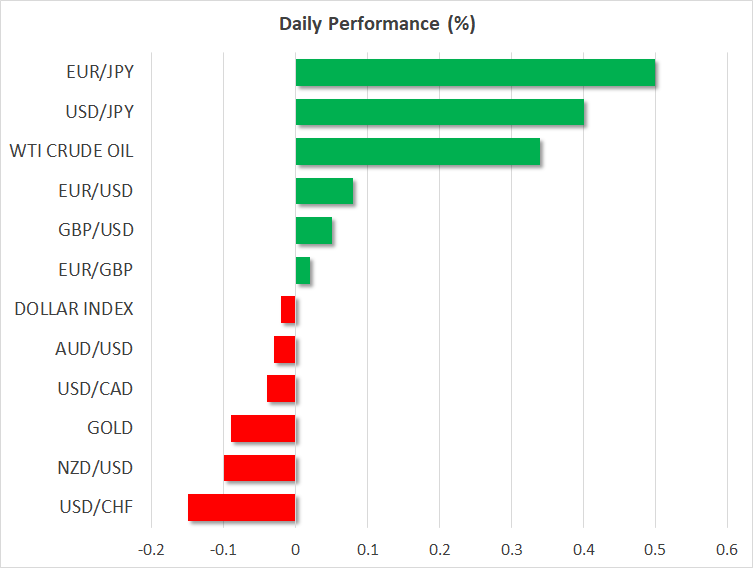- Dollar extends retreat as traders await next catalyst
- Yen slides as BoJ signals no rush to raise interest rates
- Chinese markets supported by more stabilizing efforts
- Wall Street rallies, gold holds steady, oil gains

Dollar weakens despite Collins pushing back on rate cut bets
The US dollar continued pulling back against most of its major peers on Wednesday, gaining only against the yen and the franc. The main gainer was the kiwi, perhaps as New Zealand’s better-than-expected jobs data prompted investors to scale back their RBNZ rate cut bets. The greenback seems to be stabilizing today, while extending gains against the yen.
Once again, there was no fundamental catalyst for the dollar’s weakness. On the contrary, one more Fed official joined the chorus of those pushing back against imminent rate reductions. Following Powell, Mester and Kashkari, it was the turn of Boston Fed President Susan Collins to share her view, noting that for the moment, policy remains well positioned.
Collins’ comments did not impact the market’s view on US interest rates either. The March cut probability stayed at nearly 20% and the total number of basis points worth of reductions for the whole year remained around 120.
This, combined with the fact that Treasury yields rose somewhat, suggests that dollar buyers continued realizing profits, perhaps preferring to wait for the next entry opportunity at more attractive levels. Following the astounding US jobs report on Friday, the dollar index jumped above its 200-day exponential moving average and now it is pulling back, maybe to test that average as a support.
What could prompt dollar traders to buy again near that zone might be next week’s US CPI data for January, as stickier than expected inflation could take the likelihood for a March rate cut closer to zero and possibly reduce the elevated 80% probability for such action in May.
Yen tumbles on Uchida’s remarks, Chinese stocks extend recovery
The only currency against which the dollar managed to perform well was the Japanese yen, which may have come under selling interest after BoJ Deputy Governor Shinichi Uchida said that the Bank will likely avoid raising interest rates rapidly, even after they exit negative territory.
Although Uchida signaled conviction that the conditions for phasing out stimulus are falling into place due to rising prices, investors are not fully convinced that the era of negative interest rates will end in April. The April meeting will be the first after the “Shunto” wage negotiations, where firms and unions are expected to agree on another strong pay hike. Market participants assign a 68% chance for a rate increase to 0% in April, while such a move is fully priced in for June.
The Chinese yuan rose yesterday, and it is holding steady today despite data revealing that consumer prices fell at their fastest pace in more than 14 years in January. Perhaps the currency received support from the Chinese stock market, which extended its recovery as regulators intensified efforts to stabilize the market by placing further curbs on short selling.
The head of China’s securities regulator was replaced on Wednesday as policymakers struggled to stabilize the market, while according to Bloomberg, the Regulatory Commission will soon update President Xi Jinping on market conditions.
S&P 500 hits new record, oil extends recovery
Wall Street traded in the green yesterday, with the Nasdaq rising almost 1% and the S&P 500 climbing to new record highs. The optimism surrounding this earnings season seems to have overshadowed jitters surrounding US regional banks after Moody’s downgraded New York Community Bancorp (NYSE:NYCB) to junk. The dollar’s retreat may have also helped, despite investors not altering their US interest rate bets.
The slight rise in Treasury yields and the dollar’s retreat may have acted as offsetting forces for gold which traded virtually unchanged yesterday. The precious metal is slightly lower today, which suggests that it did not attract safe haven flows either after Israel rejected a ceasefire offer from Hamas.
Nonetheless, the Middle East news was noticed by oil traders, who continued buying on fears that the conflict will continue disrupting supply. On the demand side, the stronger-than-expected drawdown in US gasoline stocks may also have added support.
